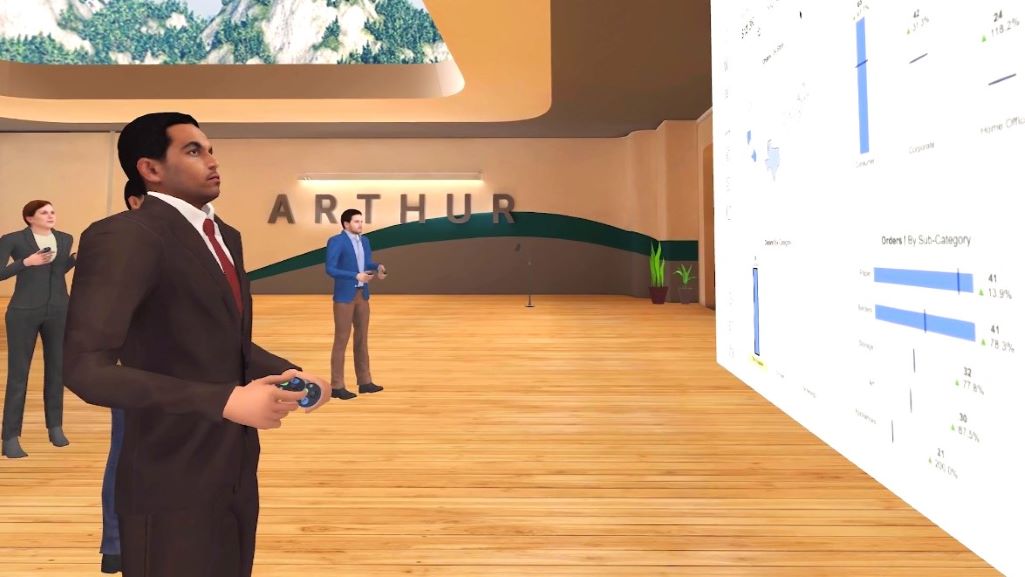What is Microsoft Mesh and will business avatars catch on?
|
Getting your Trinity Audio player ready...
|
Momentum is building behind enterprise VR. Examples include delivering expert advice remotely to engineers in the field and enabling staff in different physical locations to collaborate in the same virtual room on design reviews. The list of use cases grows all the time, which brings us to Microsoft Mesh and the topic of business avatars.
“You actually feel like you are in the same place,” comments Microsoft Technical Fellow Alex Kipman on the experience of using Microsoft Mesh – a mixed-reality platform powered by the tech giant’s Azure cloud computing platform.
Microsoft Mesh has its own website, Mesh.com, which takes visitors to all of the resources that are available to get started. And scrolling through the visuals provides a glimpse into what could become a familiar world for business avatars.
Immersive spaces for Teams.
Microsoft describes Mesh, which offers architecturally bright and welcoming conference rooms and collaboration spaces in VR, as allowing people in different physical locations to share holographic experiences on many kinds of devices.
The list of supported VR headsets includes the Meta Quest 2, which has been a big-seller not just with gamers, but with business users too (read about TechHQ’s visit to Gemba’s UK headquarters for more on that theme). And it’s worth noting that you don’t have to put on a Quest 2, or other compatible headset to join a Microsoft Mesh environment. The experience is undoubtedly more impactful when viewed in VR, but users can have their business avatars participate via regular PCs too.
For developers, Microsoft Mesh includes a navigation layer (for defining where business avatars can and can’t go) and provides spatial audio – to name just a couple of features that come straight out of the box. Plus, creators can use tools created by the Microsoft Mesh team for the Unity Engine to build custom experiences of all kinds.
There’s a person-sized dev tool that can be added to the scene to make sure that the digital assets are being built on the right scale. Also, it’s possible to activate teleportation features that users can select inside the Microsoft Mesh experience either from a VR controller or via mouse and keyboard. And developers only have to build once for synchronized experiences on PCs and VR headsets.
The tool kit includes the ability to easily place a web view inside the Microsoft Mesh creation, which is a simple way to display live online content inside the scene. Prefabricated buttons can be added to perform designated actions, making the mesh experience for business avatars even more interactive. And some big-name firms have started to explore the collaborative possibilities that VR brings to enterprises.
Microsoft Mesh entering public preview on desktop and headset with new #MicrosoftTeams experience. 😎💜https://t.co/mcmCFnAtXa pic.twitter.com/prCNADXbQI
— Jeff Teper (@jeffteper) September 26, 2023
Accenture has used Microsoft Mesh, now in public beta, to deliver a new joiner experience using business avatars. PwC configured a VR space for immersive learning and onboarding. And team members from DXC Technology gathered in their Microsoft Mesh environment to ideate on the process of design thinking, surrounded by virtual whiteboards and presentation screens.
Microsoft Mesh product managers Megha Sharma and Brent Jackson see businesses using the platform for corporate events, interactive learning, delivering guided and self-guided tours, displaying product showcases, and hosting social gatherings.
Enterprise VR is gathering speed fast, but it’s by no means mainstream, and companies need time to discover the applications that deliver value for them. However, whatever the use case, chances are that it’ll require having a digital character.
How to create business avatars
You don’t need a VR headset to get started building business avatars. If you have Microsoft Teams installed, simply add Avatars for Microsoft Teams to your work environment by clicking on the Apps button in the sidebar and searching for the add-on. From here, running the app takes you to the Avatar Builder, where you can recreate a digital version of your professional self.
Recognise this tech writer? Thought not.
Building business avatars isn’t as easy as it may sound – at least using the Avatars for Microsoft Teams app. For business avatars to work, it feels like they need to be recognizable – although characters will likely have a floating name tag to avoid confusion.
The Microsoft Teams avatar building tool has lots of options, but may need a few more to capture everyone’s individual character.
Another possibility – one that enterprise VR app developer Arthur Technologies is using to great effect, as seen by TechHQ in a recent demo – is to give users the option of uploading a digital headshot. The software then applies that face to a staff member’s avatar, making them easily recognizable to their colleagues in the virtual world.

Alternatives to Microsoft Mesh: screengrab from Arthur Technologies video showing how headshots can be used to create business avatars that are easily recognizable to colleagues and other project members. With compatible hardware, business avatars can be even more expressive – for example, by raising their eyebrows to match a user’s face in the real world.
Plus, adding a photo to an avatar is quick. Playing around with multiple options in body, face, hair, appearance, and wardrobe menus, on the other hand, takes some time. And the commitment could put people off, especially if the final creations don’t result in compelling business avatars.
Enterprise VR opportunities
Microsoft is by no means the only tech giant that’s welcoming enterprises into the virtual world. Other well-known vendors are also keen to tempt business avatars into using their own virtual collaboration spaces, providing alternatives to Microsoft Mesh. And hardware developments are helping too, as TechHQ discovered first-hand on a trip to Qualcomm’s XR (extended reality) Labs in Austria.
Processors such as Qualcomm’s Snapdragon XR2 Gen 2 platform are bringing better performance to headsets, including the recently announced Meta Quest 3. Improved graphics and pass-through video help developers to create more compelling enterprise applications, and support productivity through spatial computing.
Speaking at Meta Connect 2023, Mark Zuckerberg – Meta’s CEO – signposted some of the opportunities that XR could bring for business users. Announcements included the launch of Meta’s Quest for Business service due to go live this month. “It’s going to allow you to take mixed reality and bring it to your organization at scale,” Zuckerberg told attendees.
Quest for Business is compatible with Intune, Microsoft’s cloud-based endpoint management solution, as well as VMware Workspace ONE – another option for managing and securing any endpoint from any platform. Ivanti’s unified endpoint management (UEM) platform will also be compatible with the Quest 3 XR headset, adding to the appeal of the hardware for enterprises. And there’s more.
By the end of 2023, Microsoft 365 will be available to Quest users on their VR home screens, according to Meta. This means that staff will be able to run Word, Excel, and other Microsoft Office apps in the virtual world. And, in principle, this includes Microsoft Teams.
Microsoft Teams users, as mentioned above, have the option to use customizable avatars to ‘portray their own unique style’ in meetings. Although, as TechHQ found in testing, creating business avatars may leave users wanting more options. But it’s a first step, and Avatars for Microsoft Teams gives enterprises the option to examine whether having business avatars is something that works for them.
Another dimension to business avatars
In the discussion so far, the assumption has been that meet-ups in Microsoft Mesh and other collaborative virtual environments are between digital versions of real-life colleagues. But soon, business avatars could represent entirely virtual characters – powered by generative AI.
As Zuckerberg outlined to Meta Connect 2023 attendees, Meta’s AI studio will give users the option to deploy bespoke non-player characters (NPCs) in virtual settings. Adding value to enterprise experiences, these AI avatars, or NPCs, could be trained on business data or systems to act as subject experts or employee assistants, which could be called upon for information when needed.
If the technology delivers, Zoom meetings and Microsoft Teams calls will never be the same. And whether that is a good thing or bad, time will tell.










